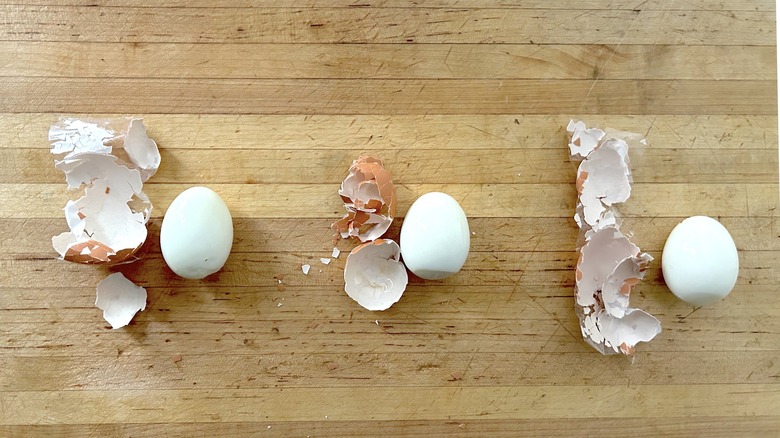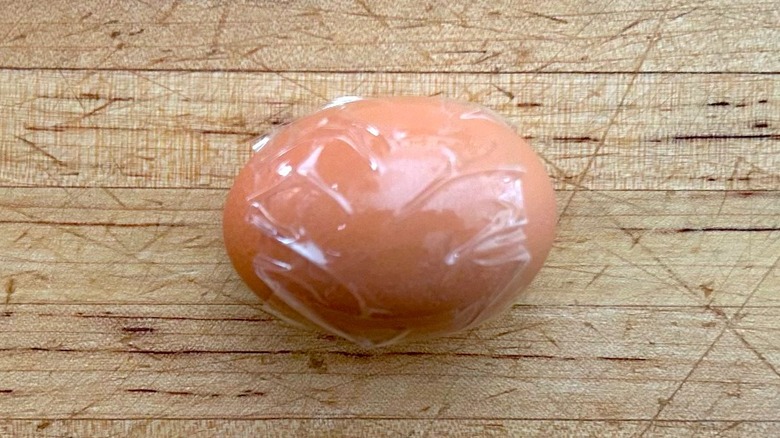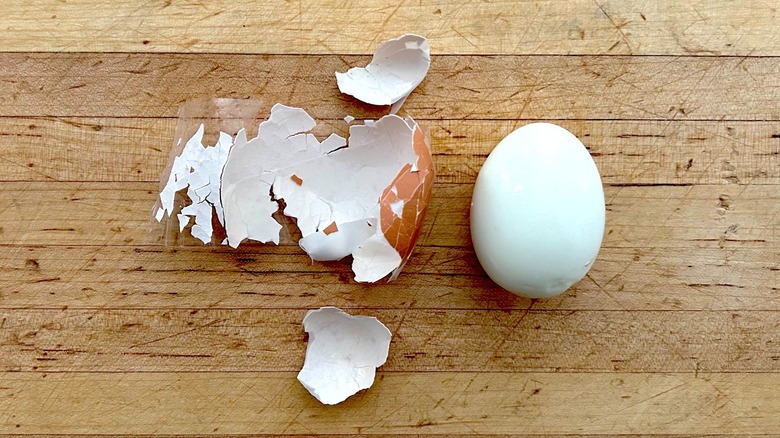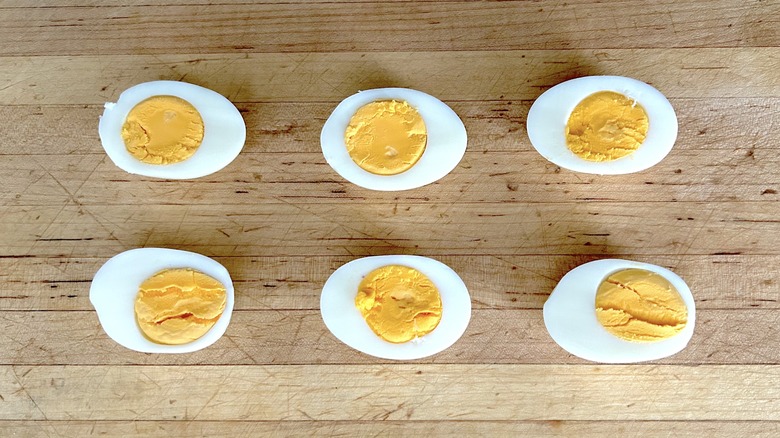How Well Does The Tape Hack For Peeling Hard-Boiled Eggs Work?
Learning how to hard-boil and peel eggs to perfection seems like one of those fundamental skills a cook masters before undertaking any other culinary technique. And yet, you'd be amazed at how challenging this task can prove to even the most accomplished chefs. Among the most frustrating parts of hard-boiling an egg is getting the shell off. Either you rip the egg in the process, or end up needing magnifying glasses and tweezers to remove tiny shards of shell from the solidified white.
There are a dizzying number of tips and hacks for peeling eggs. From boiling eggs in oil to adding baking soda to the cooking water to pricking them with a thumbtack à la Jacques Pépin, a lot of time and energy has been devoted to solving the mystery of this seemingly impossible task. One technique that piqued my curiosity as a chef with nearly 18 years of professional experience was wrapping the egg in packing tape. I decided this was as plausible as any other magical method, so I tried it.
I boiled, dried, and cooled half a dozen eggs and armed myself with clear packaging tape. My skepticism did not deter me from deliberately and scientifically testing this method so that I could report my first-hand experience with it. Is this an old wives tale, or is it legitimately useful? Read on to find out how things panned out.
What is the tape hack for peeling hard-boiled eggs?
One of the most common mistakes people make with cooking hard-boiled eggs is using super fresh eggs straight from the farmer's market. These are notoriously hard to peel, so I always use slightly older eggs for hard-boiling. My chef-approved hard-boiling method itself is standard. I place the eggs at the bottom of a saucepan and cover them with cold water. I put a lid on the saucepan and bring the water to a rolling boil. Once the water has boiled, I turn off the burner and allow the eggs to sit for 12 minutes. I then drain, rinse, and soak them in cold water for 30 minutes. Once they have cooled, I pat them dry and place them in the refrigerator for 30 minutes before endeavoring to peel them.
For good measure, I had a control egg. I peeled it by gently tapping it on the countertop around its circumference to loosen the shell before grabbing a piece near the air pocket at the bottom and pulling it off. This technique works just fine, but it can be tedious and leaves a lot of crumbled shell to clean up.
I encased an egg horizontally with packing tape for the tape-peeling method. I then loosened the shell similarly to the control egg, grabbed the edge of the tape, and pulled it back. I tested this method again, wrapping the egg in tape vertically before breaking up the shell and peeling it off.
Does the tape hack for peeling hard-boiled eggs work?
If I were a betting person, I would have put all of my money against this method working. Something about it seemed too good to be true, and I was a little uncomfortable with the idea of putting adhesive on my food. I got over this issue by reminding myself that the tape wasn't touching the part of the egg I was eating, just the shell I intended to discard. My skepticism about the efficacy of this method required a little more proof to be convinced, though.
When I removed the tape from the first egg, I was impressed with how easily the shell adhered to it. Once it got going, it pulled most of the shell off in one piece without leaving pieces or skin behind. The only parts that did not come off were at both ends of the egg. These areas did not touch the tape, so I had to remove them after the fact, but by this point, the shell had been well loosened; they came off without any fuss or damage to the egg. The second egg that I wrapped vertically worked out similarly: All the shell pieces attached to the tape came off fairly smoothly in one sheet. The sides where the tape did not touch the shell remained, but were easy to grab and pull off after being loosened.
Is the tape hack for peeling hard-boiled eggs better than other methods?
Compared to how I typically remove the shell from my hard-boiled eggs, the tape method was infinitely more efficient and left far less of a mess to clean up. The tape pulls the shell away gently enough not to tear the egg, and it adheres to a majority of the tiny eggshell shards that can get left behind by the control method. Once the eggshells were removed, I rinsed the eggs off and popped them in a Ziploc bag for storage. Clean-up involved grabbing the tape and dumping it, shell and all, into the trash — no scouring for little pieces of shell like an egg-hunting Inspector Gadget.
The only remotely annoying part of this method is that it can be hard to locate the edge of the tape on the egg's surface once you crack it. Additionally, loosening the eggshell may take a few passes as the tape acts as a buffer, protecting it. While it may seem logical to encase the egg vertically and horizontally with two pieces of tape, this will make cracking the shell even more challenging and could damage the egg. I would stick to just one layer of tape and wrap it horizontally around the egg's width. This seemed somewhat more effective than the one that was encased vertically. Regardless of how you cook your hard-boiled eggs, this is an efficient peeling method. I give it a solid A.



